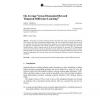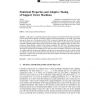119
click to vote
ML
2002
ACM
15 years 6 days ago
2002
ACM
We provide an analytical comparison between discounted and average reward temporal-difference (TD) learning with linearly parameterized approximations. We first consider the asympt...
151
Voted
ML
2002
ACM
15 years 6 days ago
2002
ACM
We present a general approach to model selection and regularization that exploits unlabeled data to adaptively control hypothesis complexity in supervised learning tasks. The idea ...
117
click to vote
ML
2002
ACM
15 years 6 days ago
2002
ACM
I describe a framework for interpreting Support Vector Machines (SVMs) as maximum a posteriori (MAP) solutions to inference problems with Gaussian Process priors. This probabilisti...
114
Voted
ML
2002
ACM
15 years 6 days ago
2002
ACM
We examine methods for constructing regression ensembles based on a linear program (LP). The ensemble regression function consists of linear combinations of base hypotheses generat...
148
Voted
ML
2002
ACM
15 years 6 days ago
2002
ACM
This paper introduces a Bayesian method for clustering dynamic processes. The method models dynamics as Markov chains and then applies an agglomerative clustering procedure to disc...
98
Voted
ML
2002
ACM
15 years 6 days ago
2002
ACM
The execution order of a block of computer instructions on a pipelined machine can make a difference in running time by a factor of two or more. Compilers use heuristic schedulers...
120
click to vote
ML
2002
ACM
15 years 6 days ago
2002
ACM
Most classification algorithms receive as input a set of attributes of the classified objects. In many cases, however, the supplied set of attributes is not sufficient for creatin...
111
click to vote
ML
2002
ACM
15 years 6 days ago
2002
ACM
We consider the existence of a linear weak learner for boosting algorithms. A weak learner for binary classification problems is required to achieve a weighted empirical error on t...
ML
2002
ACM
15 years 6 days ago
2002
ACM
Abstract. The problemof state abstractionis of centralimportancein optimalcontrol,reinforcement learning and Markov decision processes. This paper studies the case of variable reso...
ML
2002
ACM
15 years 6 days ago
2002
ACM


